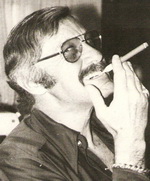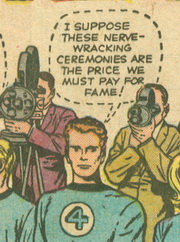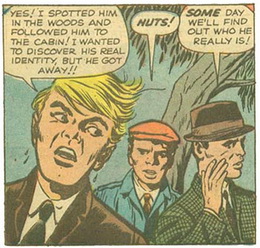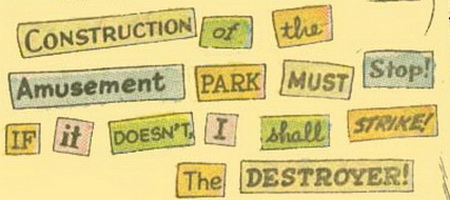
Published: October, 1962
Script: Larry Lieber
Pencils: Jack Kirby
Inks: Dick Ayers
Letters: Art Simek
It always amuses me when Marvel characters from one title “guest star” in another title. These “guest appearances” are always grandly introduced, Strange Tales #101 being no exception. On the cover we are informed that Torch appears “By permission of the Fantastic Four magazine,” and on the splash, it is boldly proclaimed that “The Human Torch appears in Strange Tales thru [sic] the courtesy of the Fantastic Four magazine.”
So, first of all, in case you didn’t get that: there’s this other magazine, Fantastic Four, and if you like what you see here, you can get lots more where this came from by plunking down another twelve cents each month for that magazine as well.
But so much hoopla about guest appearances also leads to my next question: doesn’t Marvel own it all, anyway? If we’re going to use “guest appearances” as a motif, isn’t this somewhat like the old days of Hollywood, when actors contracted with a studio, and were then obligated to appear wherever the studio told them? There’s no “permission,” or “courtesy” involved. The employee does what the boss says.
 I really get a kick out of this illusion that the characters had to be invited, hired, or contracted to appear in the new title. I have this image of Stan (much younger, no gray hair, but still with the aviator glasses) sitting at his desk, dialing his rotary phone…
I really get a kick out of this illusion that the characters had to be invited, hired, or contracted to appear in the new title. I have this image of Stan (much younger, no gray hair, but still with the aviator glasses) sitting at his desk, dialing his rotary phone…
BRRRRRNG!sp “Hey…Torch! How ya doin’, old buddy old pal! Hey, listen, Torchy: wanna ask ya a favor…”
How much money did Torch get paid for his appearances in Strange Tales? Did his lawyers go over the contract with a fine tooth comb? Now that he’s so popular, will he demand a bigger trailer, with a star on the door? And does he only work if guaranteed a constant supply of Jalapeño Fire Dorito chips?
We know that in the world of entertainment, ratings and sales are likely to go up as a result of “guest appearances,” and I suppose that’s the intention here. It’s about money, but I think it’s also just plain fun, an exercise in creativity.
In a way, you could say that “guest appearances” is how the Avengers got started. Each character “jumped title” to appear in the new Avengers comic mag. Jeez! Wonder how many phone calls Stan had to make to get THAT one organized!
RECAP
As this story starts, we meet Torch, and just in case you have no idea who he is, almost immediately we recap the Fantastic Four origin story. The recap begins with the words “For those few readers who are not familiar…”
I read this with the emphasis on “few.” It seems an assumption that pretty much everyone knows–or at least OUGHT to know–and if you don’t know, then you are not among the privileged, informed, initiated, indoctrinated. You are not part of the “in” crowd, and you need to do whatever it takes to remedy that situation as soon as possible!!
Johnny lives in Glenville with his sister Sue, whom (at least in this story) the world knows to be the Invisible Girl. However, in this story, no one knows that Johnny Storm is the Human Torch.
I repeat: in this story, no one knows that Johnny is Torch.
SECRET IDENTITY?
Huh? you may ask. And you would be right to do so. Because the Fantastic Four has just completed seven issues, and the last time we saw them, they were all bellyaching about having to show up for a Congressional Dinner in their honor. But they went, and were honored, by Congress, in public, with at least four, count ’em FOUR cameras in attendance!
 A word balloon that surrounds the text with a broken line indicates the character is whispering.
A word balloon that surrounds the text with a broken line indicates the character is whispering.
–Russ
After this, it’s highly unlikely the FF are enjoying any of the privileges of “secret identity.” In fact, at the Congressional Dinner, Reed thinks or whispers (whichever one it is when the word balloon uses a broken line), “I suppose these nerve-wracking ceremonies are the price we must pay for fame!”
Fame.
The exact opposite of secret identity.
Yet Johnny spends the entire scope of Strange Tales #101 fretting about how in the world he’s going to maintain his secret identity. He uses smoke and mirrors (almost literally) to draw attention away from himself so that he can perform two rescues. And thus his “secret identity” remains…secret.
I’m simply baffled. But we’ll get back to this issue later.
VILLAIN
For right now, let’s take a look at our villain: The Destroyer! And once again I say, what a fabulous name for a villain! And once again I say…too bad that by the end of our story this villain is caught and hauled off to jail. In fact, in the last panel, the writer tells us, “And so, the Destroyer is finished!”
Why? Why have a villain with a great name like the Destroyer, and finish him off in eleven pages? You’ll notice I say he’s a villain with a great NAME, but I didn’t say he was a great villain. Because when all is said and done, it turns out the mighty Destroyer is merely a Commie spy, and his arsenal of superpowers consists of one gun, which Torch easily melts with a single blast of flame.
I’m not going to legitimize the Destroyer’s reputation by going into further detail here. You can read more about him when you see where I’ve placed him in my Villain Valuation. Slightly higher than the Skrulls? That tells you something, right?
Well, actually, I did want to say one thing about the Destroyer. He begins his “reign of terror” (sarcastic quotes) by sending a newspaper clipping threat:
He follows by sending a couple more. Which made me think, “How hokey! How cliché!” And that made me wonder…how and when did this cliché get started? I looked all over the internet, and couldn’t find anything, so I presented the case to the Answer Man (Russ), who in about ten minutes came up with the fact that Sir Arthur Conan Doyle in his 1902 Sherlock Holmes novel The Hound of the Baskervilles employed the use of what was later to become known as the “Ransom Note Effect.”
Don’t know if Holmes was the first character to use the “Ransom Note Effect,” but apparently Marvel Comics did not invent this cliché, they simply perpetuated it. To which I say… good going! Russ and I differ on the value of clichés, but I feel there’s a reason why clichés exist. Clichés provide a common language and, as long as they are not overdone, can be effective. As this cliché is here in Strange Tales.
A dimension of irony is added to the use of the newspaper clipping note, because it turns out that the Destroyer is actually the editor of the newspaper to whom the notes are being sent! That was a nice twist at the end that I didn’t see coming. Bravo!
GUEST APPEARANCE WITHIN A GUEST APPEARANCE
The Destroyer’s third and final note to the newspaper dares Torch to meet him alone at a cabin on the outskirts of town. Because if you want to meet someone alone  that’s what you do — publish the invite in the newspaper.
that’s what you do — publish the invite in the newspaper.
You know, now that I know the Destroyer is actually the publisher of the newspaper, this makes even less sense than before. He could have decided to avoid potential complications by not publishing that note in such a public forum. However, since Torch has a “secret identity,” perhaps this was the only way he could get in touch with him.
The Destroyer takes a huge risk in assuming that no one else will show up at this secret meeting, because he almost sets himself up to have to deal with…THING! Yes, Thing shows up at Johnny’s door offering to help, but Johnny sends him away. (“The Destroyer challenged ME and I’m not gonna chicken out!”) So now we have a guest appearance within a guest appearance! Wonder what Thing demanded for this cameo…
But there are others who have read the newspaper challenge and show up near the cottage. Some teenagers manage to scare off the big bad Destroyer so the secret meeting in the cabin ends up a bust.
 However, we do get to see some wonderful examples of Marvel teenage boys in suits and ties and hats, so all in all, I would say this little diversion was worth it, just for a chuckle.
However, we do get to see some wonderful examples of Marvel teenage boys in suits and ties and hats, so all in all, I would say this little diversion was worth it, just for a chuckle.
Getting on with the story, though, Johnny figures out that the Destroyer is only going after the really tall rides at the amusement park, so he flies high and sees a Commie sub! Once spotted by “the Yankee man of fire,” the sub goes under, and Torch boils the water so they are forced to surface.
The icing on the cake is when a “Yankee” ship comes in and the Captain proclaims, “If we hadn’t spotted them by the light of the Torch’s flame, they might still be free.”
So when all is said and done, the teenage Torch saves the day, keeping the world safe for democracy.
CANON??
In some ways, this is actually a good story with a bit of mystery: who is the Destroyer, and why is he hell-bent on destroying an amusement park? Not your usual conflict. However, much of the “suspense” comes from Johnny’s efforts to maintain his secret identity…and we know he doesn’t have a secret identity! So it rings false. I feel like we’re in another universe, and I didn’t sign on for this universe! I want my FF straight up and fully out of the superhero closet, the way I’ve come to know and love them.
Who wrote this story? Who approved it? How did it get past Stan? Did he not care that the FF canon was being tampered with? And did the readers at the time not care either?
Maybe the creators figured this 12-cent comic mag will be here today and gone tomorrow and no one will remember or care that Johnny has a secret identity in these stories, but not in other stories. Maybe they never imagined that fifty years later people would be writing about their little 12-cent stories on the INTERNET!

And what’s with the editor’s note about four high school buddies that know Johnny’s secret but now one is in the army, two are at college and the last is working in Chicago?? Who cares? Why do we need to know that? How does that make things any better?
It’s because of this major flub that I just can’t get behind this story, or any of the other Torch stories in Strange Tales. I may have mentioned before, I’m a huge fan of respecting the canon, so I don’t really consider these stories part of the Marvel universe.
Now, if these stories were prefaced with a kid asking his dad to tell him a bedtime story about what it WOULD BE LIKE if nobody knew that Johnny Storm was the Human Torch, and then the dad told this story…well, that’s just about the only way this works for me.
But also, the thing I most enjoy about the FF is the interaction between the four of them, and except for the brief moment when Thing shows up, that’s not here. Johnny on his own is just not that interesting to me, with or without a secret identity.
Of course I understand that Johnny would have been of great interest to most of the young readers of the day, because he is the one character these little boys buying and reading Marvel comics could most easily identify with. And that’s probably whyw Johnny gets his own series.
 “FOR THE TECHNICALLY MINDED”
“FOR THE TECHNICALLY MINDED”
One more thing, and then I’ve got to go. Early in the story, we see that Johnny’s bedroom is composed almost entirely of asbestos, in case he has a nightmare and accidentally “flames on” while he’s asleep.
Really?? The mind boggles.
This information is provided for “the technically-minded.” Were there a lot of technically minded readers at this time? Kids who wanted to know “how can that be?”
And if there were, I wonder if the “technically minded” MINDED that Johnny is portrayed in this story as having a secret identity when, technically, he does not.
![]() These Torch stories in Strange Tales are not my favorites, so it’s unlikely I’ll review more. But I did want to weigh in on the strange phenomenon of an original work diverting from its own canon. Next time, we return to the REAL Marvel Universe and meet the love interest for the ever-lovin’ Thing!
These Torch stories in Strange Tales are not my favorites, so it’s unlikely I’ll review more. But I did want to weigh in on the strange phenomenon of an original work diverting from its own canon. Next time, we return to the REAL Marvel Universe and meet the love interest for the ever-lovin’ Thing!
| Want to read this comic on your computer? Marvel has a scan! Want to own this story? Buy the Masterworks! |
















I guess given finite time and energy, it makes sense for you to skip the Human Torch’s solo stories, but i’ll miss your villain valuations of Paste Pot Pete and Asbestos Man.
The secret identity thing is definitely muddled, and never resolves as well as i’d like. In issue #106 it seems that Johnny’s friends know but are humoring him (possibly Marvel first “retcon”!), and by issue #108 it seems like everyone knows. There may be an explanation somewhere that i’m not aware of.
As always, enjoying your reviews…
Thanks! But you won’t miss my villain evaluations of Paste Pot Pete and Asbestos Man. I’ve been waiting a long time to have something to say about Paste Pot Pete, and I’ll touch on that, when the time comes. The plan is to eventually have the Villain Valuation include the Top 10 and Bottom 10, and I can’t imagine a Bottom 10 list that didn’t include Paste Pot Pete!
My guess about Stan’s “By Special Arrangement with the publishers of FF” is that Marvel was such a small operation at the time that he wanted readers to thing it was a HUGE operation or this was a big deal, working with another huge company. Or Stan was just having a little fun. Either way, I get a kick out of it.
It was later revealed that Stan wrote the plot and Larry Lieber scripted, but that doesn’t explain the secret identity goof. Even if Lieber added it to the script, Stan as editor should have noticed the error, and continued for a few issues! Stan got a lot of grief on this and cleared it up, as Fnord 12 noted, and never mentioned it again.
Haha! I wonder if there was a deliberate attempt at “deception,” regarding the size of the Marvel operation. Personally, I like the “just having fun” explanation. Reminds me of how things were back when I was part of my high school and Jr. College campus newspaper staffs. Now THAT was fun!
These Human Torch solo stories could of been so much more, but it trips up out of the starting gate.
I agree on the Editor’s Note – There that should help clarify the whole secret identity jazz. No confusion here. ????
On the diagram why would Johnny need a flare gun? When he can just make his own flare!
On page 2, panel 4, all Johnny needs is a pipe to complete the Hugh Hefner look.
It is funny that the Destroyer is afraid of TEEN-AGERS!
The Navy should really watch that one commie standing beside the Destroyer at the end of the issue. Very shady indeed.
“Nuts!”- Johnny’s friend who sums up this issue perfectly!
“Nuts!”- Johnny’s friend who sums up this issue perfectly!
Agreed!